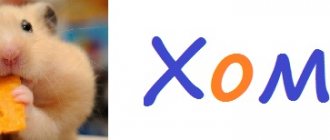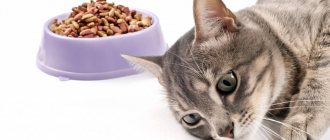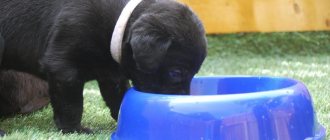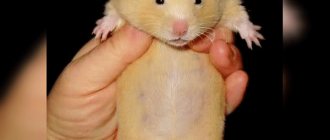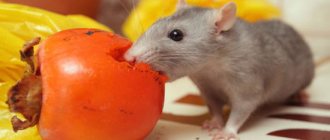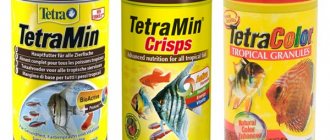A caring owner is always concerned about improving the living conditions of his pet. An important aspect of caring for a hamster is feeding. Inexperienced rodent owners are interested in how many times a day to feed a hamster so that the pet feels cheerful, stays healthy and cheerful.
Proper, nutritious nutrition is an important element that contributes to the longevity of an animal. Diet is as important as the foods that make up the animal’s diet. Read more about the list of prohibited and permitted products to avoid health problems for your pet.
Hamsters are most active at night. During the day, rodents prefer to sleep or rest. When thinking about how often to feed a hamster, you should take into account the rhythm of the animal’s life.
How many times a day should you feed your hamster?
Nutrition and diet are of particular importance for the healthy existence of a hamster.
Feeding frequency
Due to the increased activity of these pets at night, two main feeding options are preferable:
- once - late in the evening;
- twice - in the evening and early in the morning.
In this case, the main volume of food should be consumed in the evening feeding.
If the owner determines for himself a comfortable time for feeding the animal and sticks to it, then the rodent will always wait for the food it is supposed to eat at exactly this time. And such stability in the timing of food supply has a positive effect on the animal’s digestive processes.
IMPORTANT . For these small rodents, hunger strike is unbearable, so access to food must be available around the clock.
Also, due to their accelerated metabolism, these pets can wake up several times during the day to have a snack..
The breeder is also recommended to:
- Do not overfeed the animal - feeding twice a day is most optimal.
- Do not disturb the rodent's sleep by constantly feeding it throughout the day.
- Regularly audit inventory, removing spoiled products.
Amount of food
The owner must determine the amount of food for the animal, taking into account the following points:
- what is his physical activity;
- what age is the animal, since young animals need more food ;
- what is his physiological state - painful condition, pregnancy or lactation period;
- what are the environmental conditions – room temperature.
ATTENTION. According to statistical data, rodents of this kind consume an amount of food per day equal to about 70% of their body weight. Those. if, for example, a Syrian hamster weighs 150 g, then per day he will eat about 100 g of food.
The breeder does not have to resort to such precise mathematical calculations. It is enough to observe the animal for several days to determine how much food it needs. It is important not to overdo it with the amount of food, otherwise the hamster will quickly gain weight . This will have an impact on his health and life expectancy.
Amount of food
The amount of food depends on a number of factors. These include activity during the day, health status, and room temperature. It is also worth considering the age of the rodent, since the older the pet, the less food it needs.
The amount of food for dzhungarik should be two-thirds of the total body weight of the animal. The Syrian hamster, whose weight is 100–150 grams, eats approximately 100 grams of food per day. Djungarika will need 20 grams of food per day. However, as is the case with any other animals, everything is individual for hamsters. Therefore, you should not delve into complex mathematical calculations. It will be much more effective to simply watch the rodent during the day.
It is important not to overdo it with the amount of food, as they easily gain weight, and this has a detrimental effect on both digestion and overall health. https://www.youtube.com/embed/7o7ONxROBmc
https://youtube.com/watch?v=7o7ONxROBmc
Nutrition for small hamsters
In cases where a hamster gives birth to babies or very small hamsters were purchased, the owner has the question of how and what to feed such babies.
If hamsters live with their mother, then she feeds them for up to 1-1.5 months. However, if the female refuses to feed the babies or for some reason cannot do so, then the owner will have to feed the hamsters.
- First week. Newborns are fed regular infant formula via a syringe (without a needle) or dropper every three hours a day and twice at night.
- Second or third weeks. Hamsters can gradually add finely grated vegetables, fruits and food, as well as boiled porridge . In this case, you should gradually reduce the amount of infant formula.
- Fourth week. From this point on, small rodents are already able to feed on their own without any restrictions in the diet, so you can finish feeding with infant formula .
Have you ever had to supplement feeding newborn rodents?
Peculiar look
At first glance, it is clear that this is not the forest fluffy beauty that we are used to seeing in pictures. But they resemble them in the shape of their head and curved back. The Chilean degu squirrel is usually gray or brown, but these animals can also be red. On the back the hair is longer and coarser. The abdomen is usually lighter - from cream to milky in color.
The main difference from an ordinary squirrel is that this animal does not have a luxurious tail. In degus it is covered with skin, which, with a sharp tug, is removed with a stocking. After this, new skin grows on the base. Adult individuals weigh 300-400 g. Their length is approximately 40 cm including the tail. Domestic pets usually weigh and grow slightly less than their wild counterparts.
The digestion of these animals is quite sensitive, so you need to consult with the breeder and choose the food for degu that he recommends. We'll talk about this in more detail below. The squirrel's vision is not very sharp, but the eyes are located in such a way that they can provide a wide range of vision. The animal has excellent hearing and sense of smell, so it quickly and easily navigates. Moreover, regardless of the time of day and lighting. The animals live quite a long time. In nature, this period is limited to 6-8 years, and at home they often live up to 12 years.
Nutrition for elderly and sick hamsters
Animals that are sick or are already quite old (elderly) are characterized by a decrease in their activity and appetite. Therefore, the owner needs to rebuild the animal’s diet and feeding regime.
- Food should be predominantly chopped and grated. also give porridge with water or pureed vegetables without salt and sugar with added vitamins.
- To prevent intestinal disorders, your pet must be given grain food.
ATTENTION. The animal should be provided with plenty of fluids to prevent dehydration. As a drink, you can prepare a chamomile decoction or regular drinking water, but exclude honey and milk
Common feeding mistakes
To avoid health problems, you need to feed your hamster properly. Often, inexperienced owners violate nutritional rules and put their pet at risk:
- Eating too often. This leads to weight gain. Obesity causes digestive disorders, blockage of blood vessels, cardiac arrest and various dangerous diseases. That is, excess weight shortens the already short life span of rodents.
- Large portions of food. This will also lead to weight gain and the development of many diseases.
- Insufficient or irrational nutrition. A hunger strike is dangerous for a rodent, as its body suffers from a lack of nutrients, which increases the risk of various diseases. It is important to provide the animal with high-quality dry food, and to use vegetables, herbs, fruits, and protein foods for feeding.
- Feeding your pet stale or spoiled food. It is necessary to regularly remove spoiled food from the feeder. If a hamster eats spoiled or moldy food, it risks poisoning and other digestive disorders.
- Introduction of forbidden foods into the diet. You should not feed your hamster fatty, starchy, or too sweet foods.
- Irregular cleaning of the feeder. You should feed your hamster only from clean dishes. After the meal, you need to remove any leftover food and wash the container.
Feeding your hamster correctly means creating a diet of healthy and varied foods, following a meal schedule and controlling food portions. The set of rules is supplemented by regular cleaning of the cage after eating and washing the feeder. In this case, the pet will be healthy and active.
Nutrition of Djungarian hamsters
This variety of domestic rodents, such as Djungarian hamsters, has become very popular among breeders because they are not only attractive in appearance, but also unpretentious. However, breeders should also know the peculiarities of feeding such animals.
- The basis of the diet of this rodent, like others, is dry food. It is recommended to purchase several different ready-made mixtures at a pet store to balance the supply of all necessary minerals and vitamins.
- Preference should be given to cereals such as buckwheat (raw and cooked), wheat (especially sprouted), oats or oat flakes, barley, pearl barley, lentils, peas, chickpeas. Minimize rice and millet in your diet.
- Raw or oven-dried sunflower seeds without salt.
- You can give milk or cheese to animals, but not more than once a week, and choose high-quality products with a minimum fat content.
- Food rich in protein is also necessary for Djungarians, and the meat should be of a lean variety (beef, chicken) . Meat and offal should be boiled without salt and spices. You can also give your pet 1/3-1/2 of a boiled egg.
- It is better to exclude fresh bread, but a small cracker once a week is allowed.
- to pamper your hamster with nuts, berries, fruits (exclude exotic ones and remove the seeds) and dried fruits , but do not overfeed them in small quantities, since a large amount of sugar in fruits can cause diabetes.
- Vegetables should also be present in the animal’s diet - cucumbers, radishes, bell peppers, cabbage, carrots, zucchini and others. It is also recommended to give various greens, such as parsley, dill, lettuce or spinach.
REFERENCE. Rodents love to chew on tree branches, and these should be young branches of fruit crops. Coniferous species are excluded, since their resin is dangerous to the health of animals.
Djungarian hamsters will only need two main meals - in the evening and early in the morning. At the same time, food must be present in the cage around the clock - it is necessary for daytime snacks.
When should you feed your pet meat?
As a rule, hamsters spend whole days sleeping and wake up around eight o'clock in the evening, so they need to develop an evening diet. You can feed them only once in the evening, and twice in the morning, then feed them with meat, which should only be fresh and good quality, like other food. The owner of the animal must monitor the pet’s sleep and wakefulness patterns and feed it on time and at the same time appropriate for it. The type of feed required is also the same. Early in the morning, for example, around seven o'clock, you can offer your pet hearty boiled vegetables, succulent food, herbs and protein foods.
The source of protein will be meat and fish, which should be boiled and without salt. A small piece of lard will do for a hamster. Healthy food for a hamster will be chicken meat, boiled liver and beef heart. Thanks to vitamin A contained in the liver, the pet's coat improves. The second feeding is in the evening and involves a grain mixture or porridge, and hamsters do not like to go without treats. Hamsters can eat small amounts of meat-based dog and cat food.
Meat products are also recommended for females who are about to give birth to offspring. They are very healthy, along with hard-boiled eggs.
Read more about hamster nutrition here.
Another option
Experts and those who breed hamsters advise not to get carried away with vitamins. Even if you buy domestic food for your animal, the best option for it is not a vitamin complex, but a pack of imported food. It should be mixed with domestic one, and as a result you will have a mixture with all the necessary vitamins. It will cost you less.
So decide for yourself which option to use. Observe your pet and draw conclusions about what will be best for him - be guided by this.
Please rate the article
4.1730769230769 Rating 4.17 (26 votes)
We will be very grateful if you share it on social networks. Thank you!
How to choose vitamins
Buy medications in pet stores and veterinary pharmacies. Vitamins exist in solid and liquid form - in tablets and syrup. If your hamster does not agree to chew hard pellets, you can grind them into powder and add them to food. Give liquid, one drop at a time, into food or water. If their cost is important to you, then solid vitamins are cheaper. Experiment with which ones are more suitable for your pet, but not in the dose and frequency of administration. It will only do harm.
Sometimes pharmacies offer drops for hamsters. This is a treat for them. They contain pieces of dried fruits and berries, which are high in calories. Whether to buy them or not is the choice of the animal owner. But they will not replace vitamins, since they simply are not included. And if the rodent quickly gains weight, their number also needs to be reduced.
Cleaning
You can use sawdust, scraps of soft paper, or wood cat litter as bedding. If you choose the latter option, purchase unflavored granules.
Can newspapers be used as bedding for a Syrian hamster? Many people put them under the main filler. This greatly simplifies cleaning, but is very harmful to the health of the animal. Printing ink contains lead, which can cause poisoning.
The Syrian hamster has a specific smell, so it is necessary to regularly clean its cage. Change the filler on a schedule - every 2-3 days. It won't take long, and your house will always smell good.
What do they eat at home?
Hamsters will eat whatever you give them. But don’t feed them everything - the food we are used to can be deadly for these rodents.
Dry cereals are useful for a hamster: buckwheat, oats and rolled oats, barley, legumes, as well as nuts, sunflower and pumpkin seeds. Rice is given extremely rarely.
Provide the presence of fresh herbs, vegetables and fruits - wet food.
Important! Do not give your hamster fried, steamed, fatty or salty foods!!! Human food is not suitable for the gastrointestinal tract of these animals.
Syrian hamster in exercise
What can you give from greens and vegetables?
Green food is an integral part of a hamster's diet.
Cage or labyrinth?
The size of the Syrian hamster is quite small, but this does not mean that it needs a small house. Before buying an animal, think about where it will live. You have several options.
Cell
The simplest and most common home for rodents is a cage. Its minimum dimensions are 30*40 cm, but it is advisable to choose a larger cage. The distance between its rods should be no more than 1 cm, otherwise the animal will be able to escape.
It is important that the cage has at least 2 floors. Arrange a dining room and playroom on the first floor, and a bedroom on the second. 3 floors will provide even more opportunities.
Labyrinth
In addition to the cage, the pet can live in a maze. A house with many rooms on different tiers connected by pipes is very similar to a hole and the animal will definitely like it.
You don’t have to furnish your new house right away. Observe how your pet behaves. Remember where he sleeps, where he made a toilet, and where he prefers to play. Now you can start filling the maze.
Place for a cage
Where should you place your pet? You should not put it in the bedroom, as it will be very noisy at night. Most often, the place for the cage is the kitchen or hallway.
The house should not be placed near sources of light and heat. Also, the animal will be greatly disturbed by music systems and television.
What should you not give?
Animals will eat almost everything you offer them; they do not know the dangers of many foods for their stomachs. But the owner should know exactly which products are prohibited, and accordingly protect his pet from them:
- Any sausage products.
- Milk and dairy products.
- Fatty meat, lard.
- Mushrooms.
- Onion garlic.
- Honey.
- Sweets, chocolate, cookies.
- Berry seeds.
- Canned food.
- Fresh bakery.
- Pasta.
- Salt, sugar, spices.
- Various fats.
- Exotic fruits.
- Fried, fatty, spicy food.
An incorrect diet will contribute to the development of obesity, allergic reactions and digestive problems. In advanced cases, the animal simply dies.
Providing your hamster with proper nutrition is not difficult at all. The main thing is to exclude prohibited foods from his diet and make the food as varied as possible. Good nutrition will give your pet excellent health and enable it to live as long as possible.
The homeland of the charming domestic hamster is the steppe regions. These are harsh lands with winds and droughts. The steppes are not distinguished by a variety of vegetation, so the natural diet of the hamster is quite limited. In the wild, it is not easy for an animal to survive. The environment left its mark on the feeding habits of the animals and adapted them to the surrounding conditions.
Hamsters in nature have an excellent appetite and are almost omnivorous. Its menu includes all kinds of seeds, grains, and nuts. He will enjoy eating berries and nibbling on tree branches. The thrifty animal stores several kilograms of various seeds in its pantry, carefully sorting them by type.
By spring, the food supply is running low. After hibernation, a hungry animal gladly eats protein food. Snails, worms, insects, small animals help him recover and gain strength. However, in the fall he will also not refuse to snack on a worm or caterpillar. Another addition to the spring diet is young greens.
You want to pamper your fluffy with tasty things, but first you should think about whether he has access to such products in his natural habitat, and whether new treats for hamsters will harm him.
